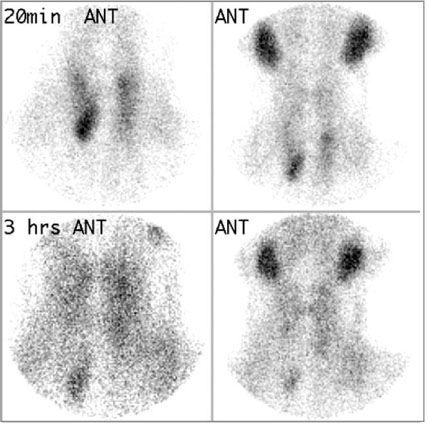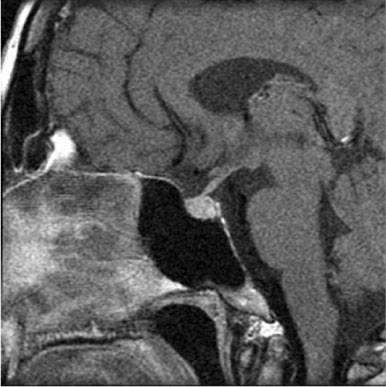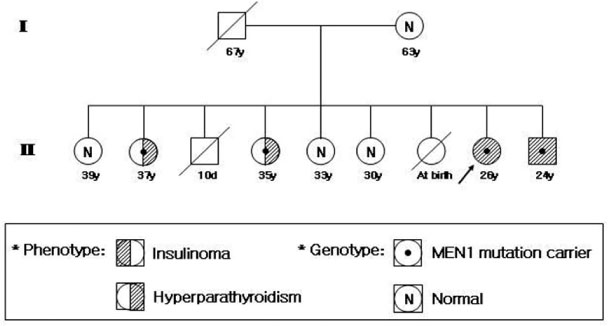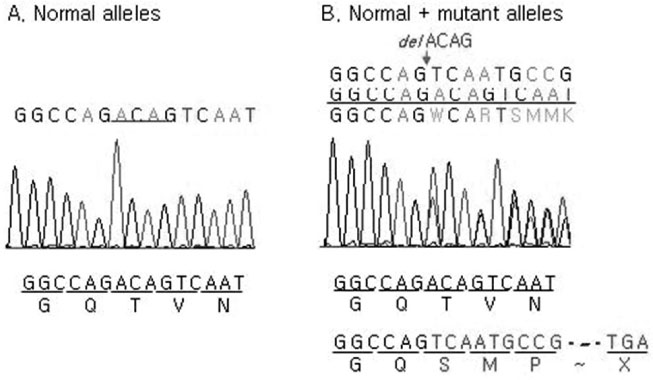J Korean Endocr Soc.
2007 Feb;22(1):68-73. 10.3803/jkes.2007.22.1.68.
A Case of Familial Multiple Endocrine Neoplasia Type 1 with MEN1 Gene Mutation
- Affiliations
-
- 1Department of Endocrinology and Metabolism, Ajou University School of Medicine, Korea.
- 2Department of Medical Genetics, Ajou University School of Medicine, Korea.
- KMID: 2178245
- DOI: http://doi.org/10.3803/jkes.2007.22.1.68
Abstract
- Multiple endocrine neoplasia type 1 (MEN1) is an autosomal dominant disorder characterized by the combined occurrence of parathyroid, pancreatic islet and pituitary gland tumors. It is caused by mutation of the MEN1, a tumor suppressor gene, with more than 400 different MEN1 mutations having been described. Herein is reported the case of a 26-year-old woman who had complained of personality and behavior changes, coupled with repetitive loss of consciousness. Her random plasma glucose and insulin were 68 mg/dL and 67.3 microIU/mL, respectively. Two pancreatic masses were noted on abdominal computed tomography, with hypercalcemia noted from a routine chemistry test. Her diagnosis was that of MEN1; therefore, her first-degree relatives were also screened. DNA analysis was also performed, from which a MEN1 gene mutation (738del4 -> new nomenclature: 628del4) was detected. Knowledge of the MEN1 mutation status could provide early recognition of a tumor.
MeSH Terms
Figure
Reference
-
1. Park JH, Kim IJ, Kang HC, Lee SH, Shin Y, Kim KH, Lim SB, Kang SB, Lee KU, Kim SY, Lee MS, Lee MK, Park JH, Moon SD, Park JG. Germline mutations of the MEN1 gene in Korean families with multiple endocrine neoplasia type 1 (MEN1) or MEN1-related disorders. Clin Genet. 2003. 64:48–53.2. Park SE, Kang ES, Lee HJ, Kim SH, Kim HJ, Do MY, Kang SA, Han SJ, Ahn CW, Cha BS, Lim SK, Kim KR, Kim IJ, Lee HC. A Case of Multiple Endocrine Neoplasia Type 1 with Mutation in MENIN Gene. J Korean Soc Endocrinol. 2005. 20:71–77.3. Lee KD, Kim JY, Mun HS, Choi SH, Lee HH, Choi YS, Park YH, Uchino S. Menin Mutational Analysis in a MEN I Family. Korean J Otolaryngol. 2005. 48:347–351.4. Marx SJ, Agarwal SK, Kester MB, Heppner C, Kim YS, Skarulis MC, James LA, Goldsmith PK, Saggar SK, Park SY, Spiegel AM, Burns AL, Debelenko LV, Zhuang Z, Lubensky IA, Liotta LA, Emmert-Buck MR, Guru SC, Manickam P, Crabtree J, Erdos MR, Collins FS, Chandrasekharappa SC. Multiple endocrine neoplasia type 1: clinical and genetic features of the hereditary endocrine neoplasias. Recent Prog Horm Res. 1999. 54:397–438.5. Guo SS, Sawicki MP. Molecular and genetic mechanisms of tumorigenesis in multiple endocrine neoplasia type-1. Mol Endocrinol. 2001. 15:1653–1664.6. Trump D, Farren B, Wooding C, Pang JT, Besser GM, Buchanan KD, Edwards CR, Heath DA, Jackson CE, Jansen S, Lips K, Monson JP, O'Halloran D, Sampson J, Shalet SM, Wheeler MH, Zink A, Thakker RV. Clinical studies of multiple endocrine neoplasia type 1 (MEN1). Quart J Med. 1996. 89:653–669.7. Benson L, Ljunghall S, Akerstrom G, Oberg K. Hyperparathyroidism presenting as the first lesion in multiple endocrine neoplasia type 1. Am J Med. 1987. 82:731–737.8. Doherty GM. Multiple Endocrine Neoplasia Type 1. J Surg Oncol. 2005. 89:143–150.9. Skogseid B, Oberg K, Eriksson B, Juhlin C, Granberg D, Akerstrm G, Rastad J. Surgery for asymptomatic pancreatic lesion in multiple endocrine neoplasia type I. World J Surg. 1996. 20:872–876.10. Doherty GM, Olson JA, Frisella MM, Lairmore TC, Wells SA, Norton JA. Lethality of multiple endocrine neoplasia type I. World J Surg. 1998. 22:581–586.11. Rasbach DA, van Heerden JA, Telander RL, Grant CS, Carney JA. Surgical management of hyperinsulinism in the multiple endocrine neoplasia, type 1 syndrome. Arch Surg. 1985. 120:584–589.12. van Heerden JA, Edis AJ, Service FJ. The surgical aspects of insulinomas. Ann Surg. 1979. 18:677–682.13. Chandrasekharappa SC, Guru SC, Manickam P, Olufemi SE, Collins FS, Emmert-Buck MR, Debelenko LV, Zhuang Z, Lubensky IA, Liotta LA, Crabtree JS, Wang Y, Roe BA, Weisemann J, Boguski MS, Agarwal SK, Kester MB, Kim YS, Heppner C, Dong Q, Spiegel AM, Burns AL, Marx SJ. Positional cloning of the gene for multiple endocrine neoplasia-type 1. Science. 1997. 276:404–407.14. Larsson C, Skogseid B, Oberg K, Nakamura Y, Nordenskjold M. Multiple endocrine neoplasia type 1 gene maps to chromosome 11 and is lost in insulinoma. Nature. 1988. 332:85–87.15. Lubensky IA, Debelenko LV, Zhuang Z, Emmert-Buck MR, Dong Q, Chandrasekharappa S, Guru SC, Manickam P, Olufemi SE, Marx SJ, Spiegel AM, Collins FS, Liotta LA. Allelic deletions on chromosome 11q13 in multiple tumors from indivisual MEN1 patients. Cancer Res. 1996. 56:5272–5278.16. Knudson AG Jr. Mutation and cancer: statistical study of retinoblastoma. Proc Natl Acad Sci USA. 1971. 68:820–823.17. Schussheim DH, Skarulis MC, Agarwal SK, Simonds WF, Burns AL, Spiegel AM, Marx SJ. Multiple endocrine neoplasia type1: new clinical and basic findings. Trends Endocrinol Metab. 2001. 12:173–178.18. Poisson Ariane, Zablewska Barbara, Gaudray Patrick. Menin interacting proteins as clues toward the understanding of multiple endocrine neoplasia type 1. Cancer Letters. 2003. 189:1–10.19. Giraud S, Zhang CX, Serova-Sinilnikova O, Wautot V, Salandre J, Buisson N, Waterlot C, Bauters C, Porchet N, Aubert JP, Emy P, Cadiot G, Delemer B, Chabre O, Niccoli P, Leprat F, Duron F, Emperauger B, Cougard P, Goudet P, Sarfati E, Riou JP, Guichard S, Rodier M, Meyrier A, Caron P, Vantyghem MC, Assayag M, Peix JL, Pugeat M, Rohmer V, Vallotton M, Lenoir G, Gaudray P, Proye C, Conte-Devolx B, Chanson P, Shugart YY, Goldgar D, Murat A, Calender A. Germ-line mutation analysis in patients with multiple endocrine neoplasia type 1 and related disorders. Am J Hum Genet. 1998. 63:455–467.20. Sakurai A, Shirahama S, Fujimori M, Katai M, Itakura Y, Kobayashi S, Amano J, Fukushima Y, Hashizume K. Novel MEN1 gene mutations in familial multiple endocrine neoplasia type 1. J Hum Genet. 1998. 43:199–201.21. Teh BT, Kytola S, Farnebo F, Bergman L, Wong FK, Weber G, Hayward N, Larsson C, Skogseid B, Beckers A, Phelan C, Edwards M, Epstein M, Alford F, Hurley D, Grimmond S, Silins G, Walters M, Stewart C, Cardinal J, Khodaei S, Parente F, Tranebjaerg L, Jorde R, Salmela P. Mutation analysis of the MEN1 gene in multiple endocrine neoplasia type 1, familial acromegaly and familial isolated hyperparathyroidism. J Clin Endocrinol Metab. 1998. 83:2621–2626.
- Full Text Links
- Actions
-
Cited
- CITED
-
- Close
- Share
- Similar articles
-
- A Case of Familial Multiple Endocrine Neoplasia with MEN1 Gene Mutation
- Imaging Finding of Multiple Endocrine Neoplasia Type 1: Case Report
- A Case of Familial Isolated Primary Hyperparathyroidism with a Novel Gene Mutation
- Multiple Endocrine Neoplasia and Familial Medullary Thyroid Carcinoma
- A Novel Germline Mutation of MEN1 Gene in a Young-aged Multiple Insulinoma with Hyperparathyroidism






